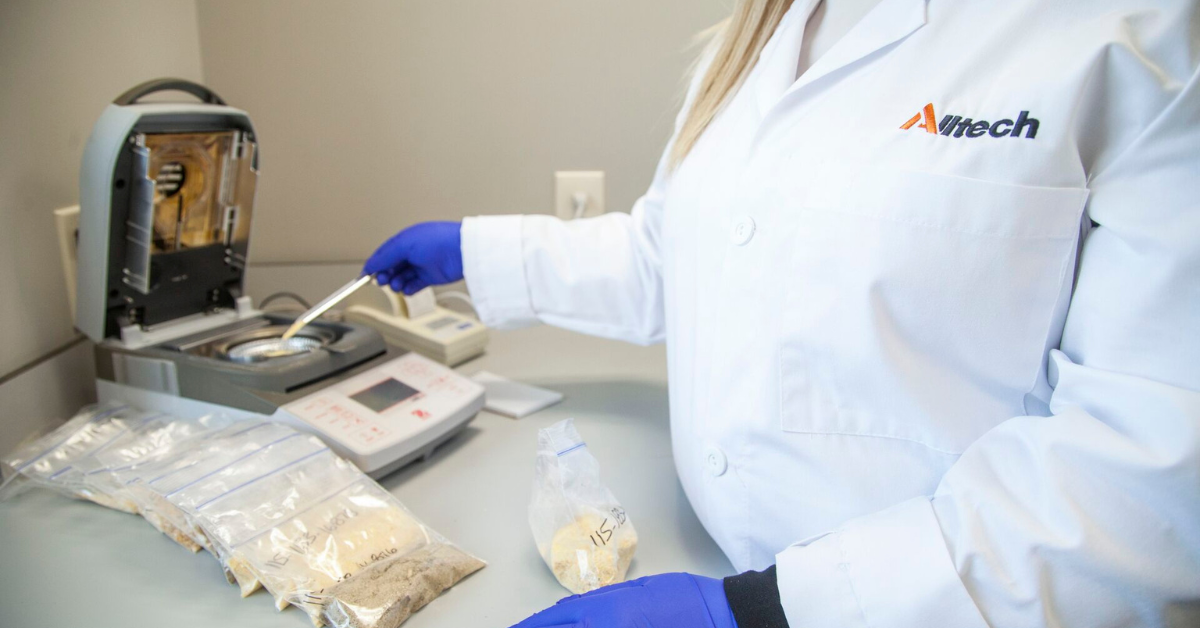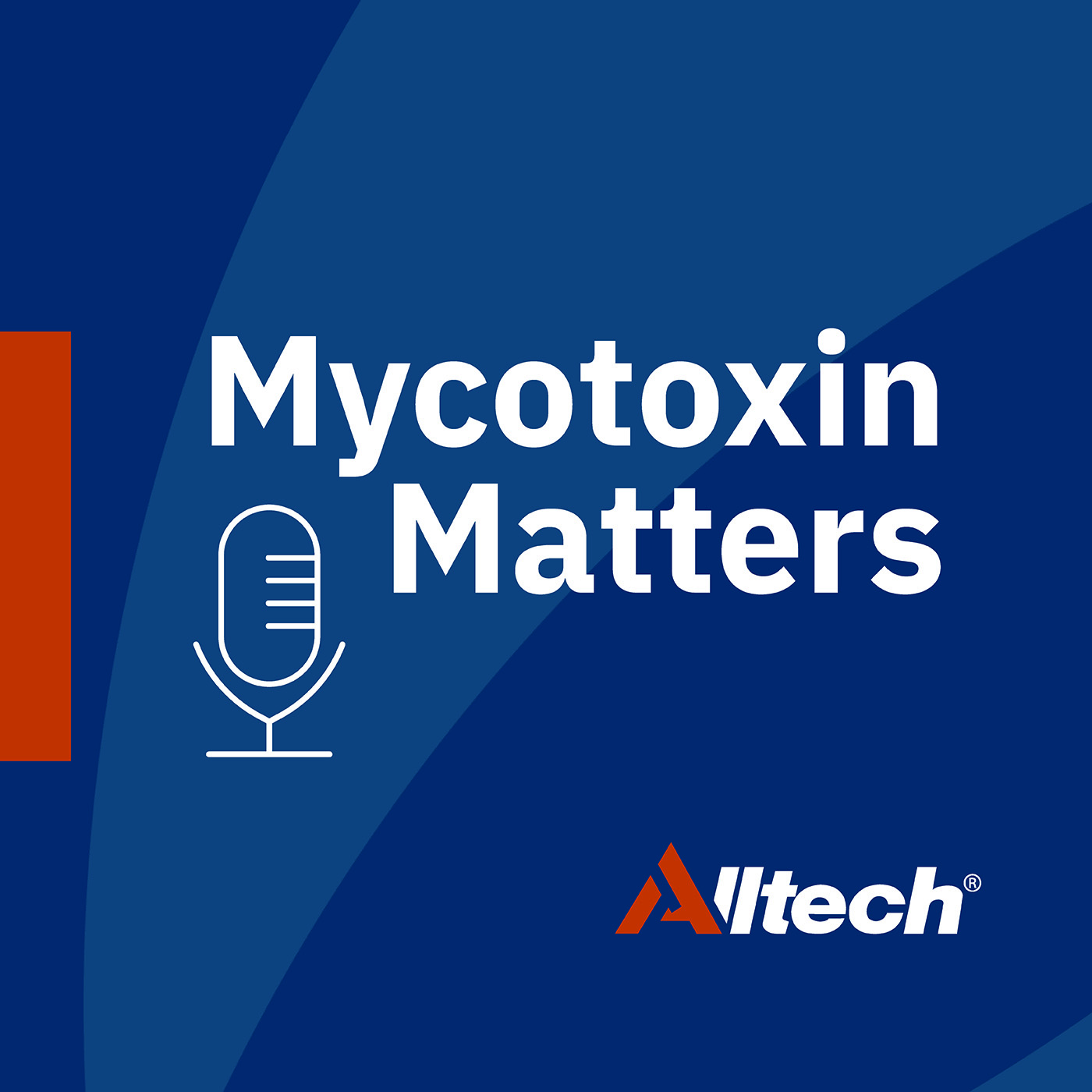Keep ahead of the threat
Stay up to date with the latest mycotoxin information by signing up to our newsletter

Choosing the right mycotoxin test for your business
Author: Martin Minchin, Mycotoxin Management Marketing Manager, Alltech
Click below to listen to the Mycotoxin Matters podcast episode with Dr. Alexandra Weaver, hosted by Martin Minchin. Choosing the right mycotoxin test for your business is a crucial step in managing the challenge that mycotoxins present to livestock operations. In this episode Dr. Weaver discusses the key differences between the available testing methods, why it is important to test for mycotoxins and what to consider when choosing a method for your business.
You can listen to the episode on Apple Podcasts or Spotify. You can also find an edited transcript at the bottom of this page.
Knowledge is power when it comes to effectively managing the dynamic challenge that mycotoxins pose to the productivity of even the best-run livestock operations. Being both invisible and odorless, the task of detecting these unwanted toxic compounds relies upon a range of specialist detection methods, each possessing their own strengths and weaknesses when it comes to deploying them in a mycotoxin control program. Some areas to consider when selecting a testing method include:
- The type of ingredients or feedstuffs that are being analyzed
- How often you are carrying out analyses
- The time required to access the results
- The cost of each testing method
What testing methods are available?
Mycotoxin testing methods can generally fall into two categories, on-site or rapid test systems, and the more sophisticated laboratory-based detection systems. To make a quick distinction between the two, rapid tests are generally used when testing individual raw materials and can typically detect up to six of the key mycotoxins. In comparison, lab-based testing is used for more complex feedstuffs such as finished feeds and TMRs and can simultaneously detect a much higher number of mycotoxins.
Rapid test methods
Lateral flow devices (LFDs) and enzyme-linked immunosorbent assays (ELISA) are the two primary rapid test options. Both of these methods provide a quick and relatively inexpensive way to screen individual ingredients, and are typically capable of detecting the levels of the six most well-known mycotoxins (aflatoxin, deoxynivalenol, zearalenone, fumonisin, ochratoxin and T2/HT2).
To detect mycotoxins, LFDs use specific antibodies that will recognize and bind to the target mycotoxin that is present in the sample. If the target mycotoxin is present in the sample being analysed, it binds to the antibodies on the test strip, and a coloured line will be visible. The intensity of this line represents the amount of mycotoxin that is present. If the sample is free of mycotoxins, or below the level of detection, a line will not appear. Quantification of mycotoxin levels is possible with a specialized reader or even through a smartphone app.
Similar to LFDs, ELISA tests rely on the interaction between specific antibodies and mycotoxins that are present in a sample. The main difference with ELISA is that instead of using an antibody-coated test strip, ELISA technology uses antibody-coated microwells and a secondary antibody conjugate solution that is linked to an enzyme, which creates a detectable signal using substrate that remains when any unbound material is removed. The color change that results from the reaction between the substrate and the enzyme can be measured using a spectrophotometer or microplate reader. Proportionally, the intensity of the signal created is inverse to the levels of mycotoxins present, i.e., the darker the color, the less mycotoxin that is in the sample. Comparing the signal intensity that is generated against a set of known standards allows for the determination of the concentration of mycotoxin that is present in the sample.
Pros and cons of rapid test methods
| Pros | Cons |
| Quick generation of results, less than 25 minutes | Only detects up to six main mycotoxins, individually |
| Relatively inexpensive compared to lab-based reference methods | Not suitable for finished feeds or total mixed rations (TMRs) |
| Allow for on-site testing | Less sensitive than more advanced laboratory methods |
| Do not require trained lab technicians | Some providers still use chemical solvents |
Near infrared spectrometry
A mycotoxin detection method that does not fall neatly into either the rapid test or lab-based category, but has been receiving greater attention in recent years, is near infrared spectrometry (NIR). It works by revealing the interaction between electromagnetic radiation and chemical bonds in a given sample. Available as both handheld or desktop devices, similar to LFDs or ELISA methods, NIR offers a quick and inexpensive way to screen samples for mycotoxins. This system does, however, have a number of limiting factors, including large standard errors, lack of sensitivity and the inability to meet the demands of regulatory compliance in a testing program. This inability to accurately quantify mycotoxin concentrations means NIR remains an initial screening method that will highlight if a sample contains high or low toxin concentrations, with further testing required to accurately inform what mycotoxin control solutions should be implemented.
Lab-based methods
Of the lab-based methods that are available, high performance liquid chromatography (HPLC) and liquid chromatography tandem mass spectrometry (LCMS/MS) are two of the most recognized options.
HPLC is based on the separation of mycotoxins in a sample using a high-pressure liquid chromatography column that contains a solid absorbent material. This stationary adsorbent material interacts with the mycotoxins in the sample, leading to their separation based on physical and chemical properties. Once separated, the mycotoxins are passed through a column at high pressure via a detector. As it passes through, the levels of mycotoxins is determined by comparing the signal that is given off against a set of known standards.
LCMS/MS involves a combination of using the separation techniques that HPLC delivers with the powerful analytical properties of mass spectrometry. Once the sample extract has been separated based on its chemical and physical properties, the compounds are then sent to the mass spectrometer. The first mass analyzer acts as a filter and only allows compounds of a certain mass through. For example, if it is set to a mass of 313 m/z, it will only let aflatoxin through, whereas another mycotoxin, like DON, with a mass of 297 m/z would not progress.
The selected mycotoxin continues to a collision cell, which fragments the compound into its components. These fragments act as a fingerprint for each mycotoxin. Upon reaching the final mass analyzer, individual fragments can be filtered again. This profile provides the confirmation of the mycotoxin presence since each compound will fragment in unique ways. This is what makes LCMS/MS so powerful; it allows control over interfering peaks by removing them, which helps its specificity, selectivity and sensitivity.
Pros and cons of lab-based analysis
| Pros | Cons |
| Extremely sensitive, low detection limits | More expensive per sample than rapid test kits |
| Detects broad range of mycotoxins simultaneously, including emerging, storage and masked toxins | Expensive equipment to purchase |
| Suitable for a wide range of feedstuffs including finished feeds and TMRs | Longer time between sample collection and results due to shipping to laboratories |
| Internal standards provide normalization, improve extraction recovery and help verify results | Requires skilled technicians to operate the equipment |
Making a choice between testing methods
It is often tempting to turn the debate between mycotoxin testing methods into a mutually exclusive outcome. In reality, it does not need to be an either-or decision, rather different methods can act as complementary tools in a mycotoxin control program. Methods such as LFDs and ELISA can provide the basis for a routine testing or quality control programs that delivers results speedily and, in a cost-effective manner. Complementing this, HPLC or LCMS/MS methods can be used on a more periodic basis to validate and support routine monitoring. Where samples like finished feeds or TMRs need to be tested, producers still only have one option, lab-based analysis.
When making a decision about mycotoxin testing programs, it is important to consider what systems allow for the generation of insights with regards to species risk and recommendations on the application of nutritional solutions. As data analysis capabilities continue to accelerate, more accurately linking mycotoxin risk to animal productivity outcomes could be one of the next frontiers in the quest to better understand and manage this complex and ever-growing challenge.








